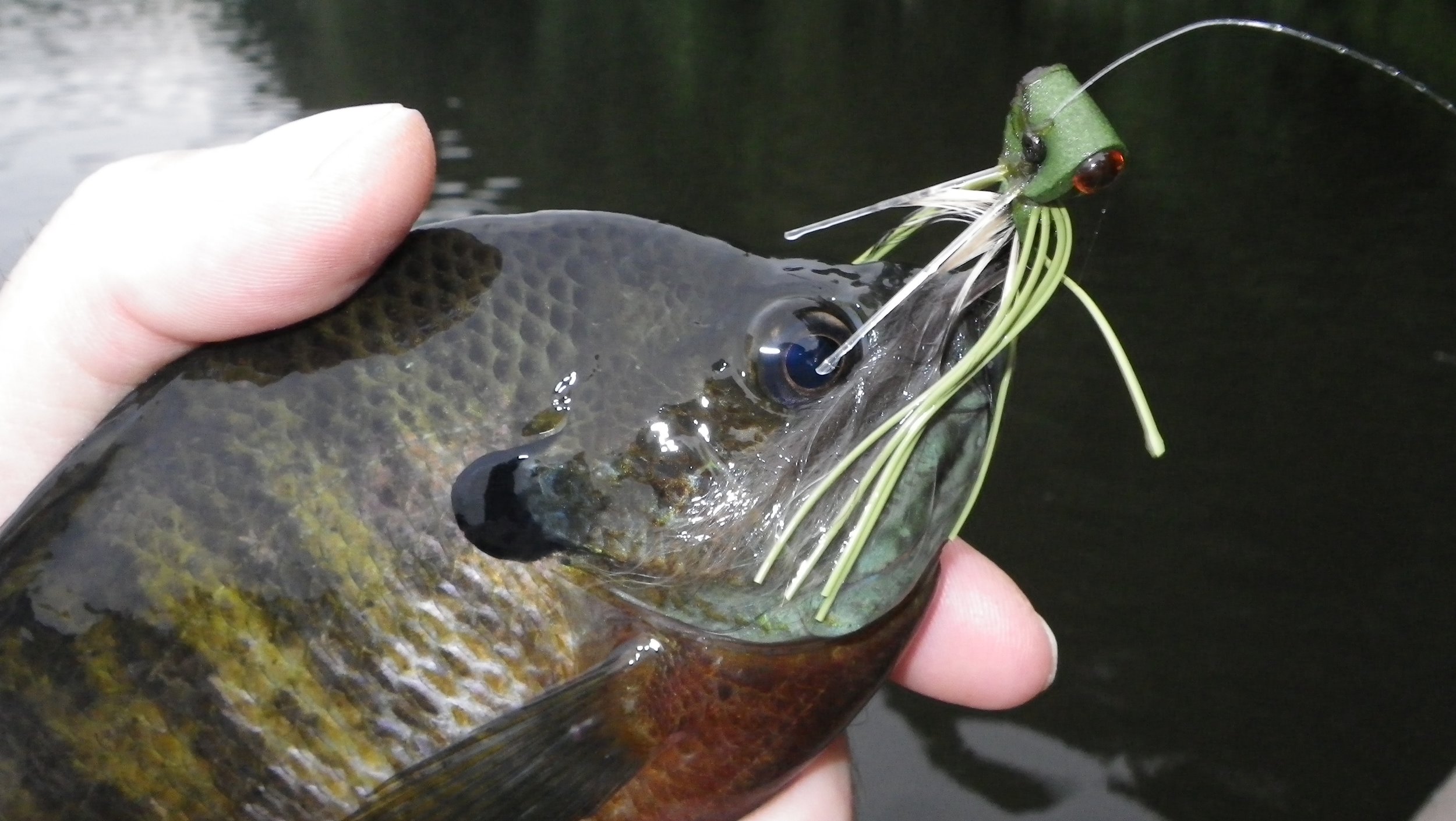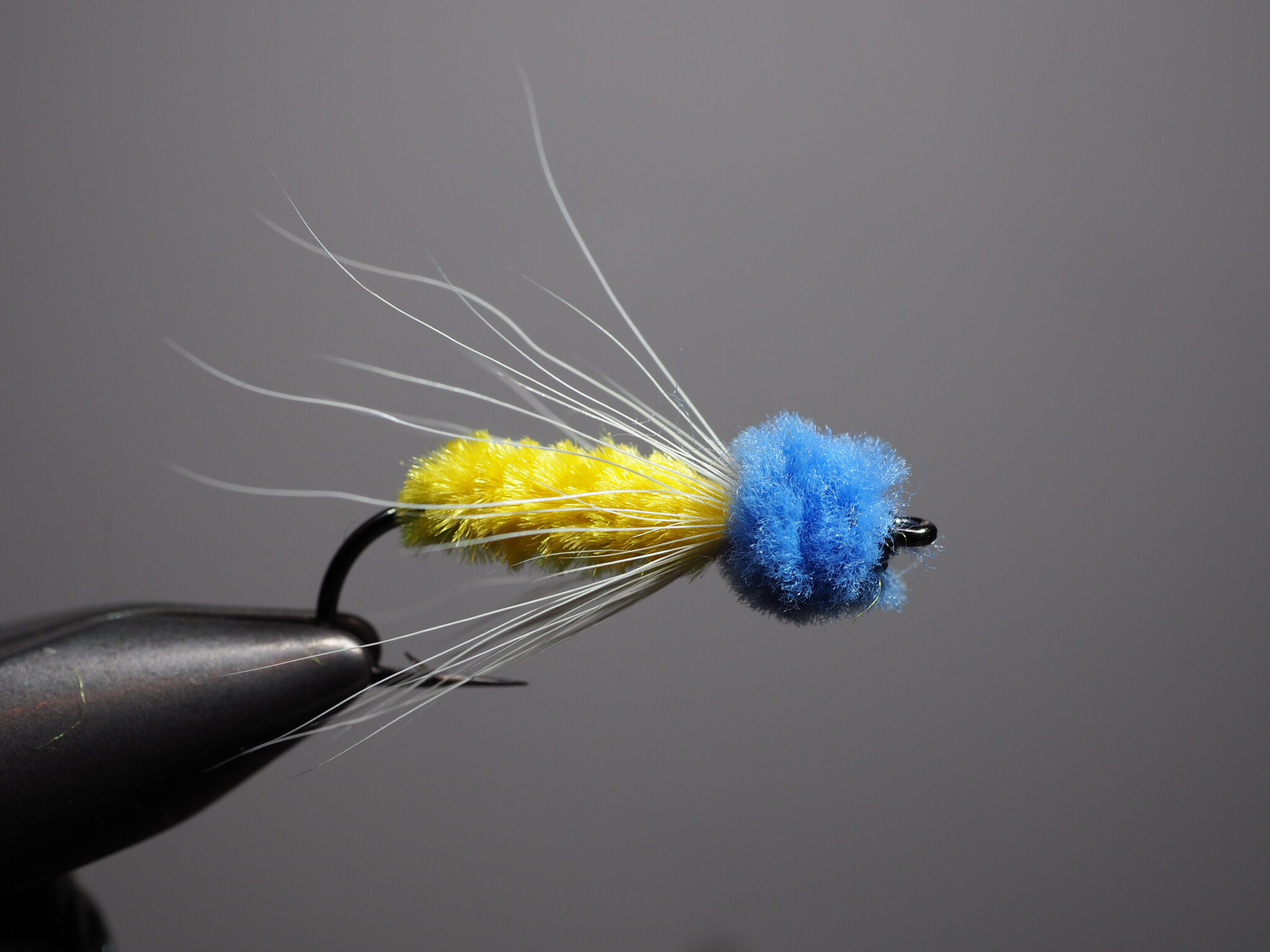Do you want to catch big panfish? Try fishing larger flies! Most anglers fish flies in the 8-12 size range for panfish. They use small flies for good reason as bluegills and other sunfish have small mouths. That being said, larger panfish have the uncanny ability to cram large objects into those tiny mouths. Think back to the years before you picked up a fly rod for the first time. Many of you probably had a background in spin or bait casting. How many times were you surprised by a large bluegill that ate your crank bait, spinnerbait or 7" plastic worm that was intended for largemouth bass? It was these experiences that led me to start throwing larger flies when I want to target big panfish.
This size 4 top water bug was doing a number on the local bass and pickerel population before this bluegill decided to make a meal of it.
How Big Is BIG?
I am always amazed at the size fly that can be crammed into the mouth of a large bluegill. While I have occasionally hooked large sunfish on bass flies larger than a size 2, I consider a size 6 or 4 hook the perfect platform to build a fly to target large panfish. A size six seems to be the sweet spot. A fly that size is large enough to attract the attention of large bluegill and the occasional bass but it small enough to catch fish in the 6-8 inch range as well.
Expect Fewer But Larger Fish.
Fishing larger flies may result in lower numbers, but you will be rewarded with larger fish!
The downside to fishing larger flies is that you will usually catch fewer fish. It is not that smaller panfish will not be interested in your offerings its just that they have a hard time getting their little mouths around them. Another downside will be missed hits. Often smaller fish will pick up a large fly, and you will detect the hit. When you go to set the hook, there is nothing there. That is because the smaller fish were only able to grab a portion of the fly and did not have the business end (the hook) in their mouths. If you're looking to keep your rod bent all day long its best to go with smaller flies.
The good news is that larger flies often attract the attention of larger fish. Often these fish will ignore standard-sized offerings then viciously attack a larger fly. Just like their cousins, the largemouth bass once they get big, their feeding habits change. A 12-inch bass may be content to chase down dragonflies all day long, but once that fish gets larger, it’s feeding habits will change. The larger fish select larger food items, expend as little energy as possible and feed less often. My experience has shown me that large bluegill and other sunfish are no different than bass in that regard.
The Diet Of A Large Bluegill
There is no doubt that large bluegills eat the same things their smaller siblings do. As they grow bigger, they add more items to their diet. These include things like large dragonfly larva (and adults), crayfish, baitfish including young of the year bluegills, larger terrestrial insects like hoppers and cicadas even tadpoles and small frogs. If they can cram it into their mouths, it is fair game. I learned this lesson myself several years ago. A few of the lakes I fish have large numbers of tree branches that extend over the water. Birds build nests in those branches, and occasionally the young birds fall or get pushed out of the nest. I observed this firsthand once, and the bird disappeared in a swirl instantly, the moment it hit the water. I suspected a bass was behind the attack and that night I tied a few baby bird imitations made out of spun deer hair. The next time I was on the water, I tried my new creation. The first fish I caught on it was a bluegill! I thought it was a fluke, but I took two more 11 inch bluegills on that fly before I hooked my first bass!
Flies for big panfish
Take a popular panfish pattern and supersize it to attract larger fish!
Fishing baby bird imitations for big bluegills may not be for everyone, but fortunately, you have a lot of other options. You can turn your standard bluegill patterns into big fish flies by supersizing them. Here are a few of my favorites.
Big Nymphs
A large Bream Killer is an ideal fly for big panfish.
Take a fly like the iconic Bream Killer. It is typically tied in a size eight to ten. Tie them in size six or four, and they become an excellent fly for targeting large panfish. Believe me, a bluegill 8" or larger will have no problem annihilating a size six fly.
This chunky bluegill had no problem engulfing this size Bream Killer!
The Creature is also good choice for jumbo panfish. It is a mouthful for all but the largest fish.
Streamers
The James Wood Bucktail, an unusual but highly effective panfish streamer!
Baitfish patterns are another favorite of mine for large panfish. As a bluegill grows in size, small fish begin to appear on the menu. Anything from the classic woolly bugger to more imitative streamers will work on large panfish. My favorite big fish fly in this category is the James Wood Bucktail. This pattern will be familiar to long-time readers of this blog but is likely unknown to many of you. The James Wood Bucktail is a creation of Harry Murray, the owner of Murrays Fly Shop in Edinburg, Virginia. It has its roots as a bonefish pattern, but Mr. Murray created this pattern to imitate a juvenile sunfish to target smallmouth bass on his local waters. It does not look like a sunfish to me, but Harry was on to something when he developed this fly as the fish love it!
That is a size 6 James Wood Bucktail deep inside this healthy bluegill’s mouth!
My “Pumpkinseed” variation of the James Wood Bucktail is another big panfish favorite!
Bass of this size will often grab a James Wood Bucktail. They may not be huge but can be a blast on a light panfish rod!
Topwater Bugs
The sky is the limit here all of the standard patterns will work just go a little larger. Again simply upsize your fly to a size six or size four and your good to go! A favorite this summer has been a big, chunky ,black Fat Albert. The Fat Albert will float like a cork all day long and will support the biggest panfish nymph in your box if you want to hang a dropper off it. It has a provides a buggy silhouette with wiggly rubber legs pointing in every direction. Tied on a long shank size six hook, it is a mouthful for all but the largest panfish but they can’t resist it! I have caught enough bass on this pattern that it has earned a permanent spot in my bass box as well!
This fish may not be large but it had no difficulty slurping up this big Fat Albert! Don’t be afraid to use larger flies for panfish!
Hold On Tight!
One of the added benefits of fishing larger flies is that these flies will attract the attention of larger predators. Bass, pickerel, pike even the occasional catfish will show interest in your larger offerings! You may catch fewer panfish, but if you throw a few bass in the mix, it can make for a good day on the water.
Larger panfish flies often attract the attention of larger predators like largemouth bass.
A Word On Conservation
Remember those larger panfish are important in maintaining healthy fish populations! If your keeping fish for the pan let the big ones go and fill your string with fish under 8”!
Please put some of those big ones back to ensure good fishing in the years to come!















